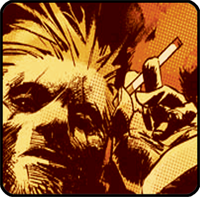1. READERS WILL ONLY LOOK AT A PANEL FOR 5 SECONDS, SO DON’T SWEAT IT TOO MUCH.
I understand the intention of this bit of wisdom, and I mostly agree with it: drawing great interiors is important, but at the same time, you don’t want to get bogged down with small details that most readers won’t even notice.
But here’s my concern with this: if you treat every panel like it’s disposable, then you’re less likely to make an impact with readers.
Think of it this way: even if readers ONLY look at a panel for 5 seconds, and your book sells 20,000 copies, then that tiny panel you were fretting over will be looked at for 100,000 seconds, which is around 28 hours of total viewing time. So, if you have the time and energy, try not to phone it in.
If the art is good enough then people will look longer than 5 seconds; readers will appreciate your extra effort even if they don’t see every detail. And if you get REALLY good–if your art is thoughtful, layered, and compelling enough to withstand a second, third or forth viewing without falling apart– then other artists will study you, which means they might be looking over your panels for hours.
2. TO BE A PRO, YOU NEED TO BE AT LEAST 2 OF THESE 3 THINGS: TALENTED, NICE, OR ON TIME.
I wish this was true. In fact, I wish that a professional artist had to be ALL 3 of these things in order to succeed–but they don’t.
If you’re talented enough, then you don’t need to be timely or nice. Proof? We all know that some creators are always late. And on Twitter, we often see these same creators acting unsavory. So why do they have careers? It’s because they’re talented and sell well–publishers see them as an asset are willing to put up with difficult/late creators if the sales are high.
Keep in mind I’m not giving anyone full license blow deadlines and act like a jerk. If you can be all 3 of these things, you’re better off. I’ve always liked this bit of wisdom, but I’d like to adjust it:
For me, success is…
70% talent
10% being nice/easy to work with
10% being on time
10% blind luck.
The numbers are all subjective, of course.
3. IF YOUR PAGES ARE GOOD, THEN EDITORS/PUBLISHERS WILL NOTICE.
You can be the best artist on the planet, and some editors/publishers might not see it. They tend to respond more to sales figures, internet hype, and buzz by the office water cooler. It’s frustrating, but understandable. At least to me.
Try to keep in mind that most editors aren’t trained as artists, they’re trained as administrators and coordinators. They worry about shipping books out, not about facial expressions, mood lighting and fish-eye lensing–that’s your job. Most editors are swamped with more work than they can handle, and they work for publishers who have hundreds of creators to keep track of. Getting dozens of books out on time is a difficult task, and while most everyone at these companies makes a genuine effort to put out a good, consistent product, sometimes things fall through the cracks. Plot lines don’t come together, books ship late, and sometimes valuable talent gets overlooked.
So if you think you’re talented, and you’re frustrated that editors aren’t noticing, don’t take it personally. Hang in there, keep plugging away, and if you’re truly talented, eventually someone will notice.
And if you meet a talented editor who DOES have an eye for art–someone like my friend Mark Doyle who edits me on The Wake–stick with him.
4. DRAW EVERY DAY.
Yes–practice, practice, practice. But once in a while, take a break and PURPOSELY let your drawing skills erode. When you relearn them, you’ll come back a bit stronger.
This job is demanding, and if you’re not careful you can end up in a sweaty, nervous, nail-bitten mess as you struggle to hit your deadlines. When you’re in this state, you’re probably putting out B level work. You start making mistakes you don’t see while developing other bad artistic habits. Your style becomes stale and incestuous (when was the last time you actually LOOKED at a photo ref of a tricep?). And when you’re in this state, you’re usually not growing as an artist because your main goal is output–things are going out, nothing is going in.
Taking a break from drawing and letting your skills erode seems counter productive, but it’s a good way to ditch bad habits and re-approach your style in new ways. It’s like when master chess players set up matches with amateur players–they end up learning more about chess when the game gets shaken up.
5. DON’T GOSSIP.
It’s naive to think you can avoid gossip, so I say embrace it in a healthy way. Gossip is a commodity, and it should be traded just like any other commodity.
I know “gossip” is a dirty word. And yes, gossip can often lead to useless, Jersey Shore style hen-pecking. But there’s a lot of good information in gossip, and I don’t see the shame in filtering it in a fair, balanced, and mature manner to help you make better decisions. Gossip can create friendships, solidify loyalty, help you avoid swindlers, spread helpful memes, weed out unsavory trends and raise awareness about issues that need fixing.
The “women in comics” issue is a perfect example of gossip being well utilized. The information came along with a lot of mud slinging, of course, but at the end of the day we’ve all had our awareness raised, and it’s a good thing.
The trick is to utilize useful gossip while discarding TMZ style gossip. There’s an art to it, and getting good at it requires practice. If you can ignore it–fine. But it might be worth listening in every now and then.
